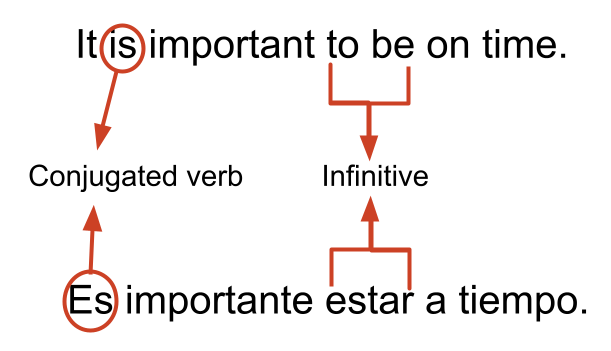Unidad 3: Mis planes
6. Los verbos irregulares en el modo indicativo en el tiempo presente
 You know the verb is the heart of the sentence. It tells you the action that the subject is doing. Understanding some basic grammar elements will make forming verbs easier.
You know the verb is the heart of the sentence. It tells you the action that the subject is doing. Understanding some basic grammar elements will make forming verbs easier.
We have several verb tenses that are used within a mood in languages. The following chart summarizes them and what “mood” means. In English as in Spanish we have three moods: indicative, imperative and subjunctive. Each one of the moods has specific tenses. For now, we will focus on what is actually happening in the present tense in the indicative mood → the Present Indicative. The rest of the chart gives you an idea of how, in several Spanish courses, you will communicate about actions depending on the time period referenced and the mood (the reality vs the opinion based).
Indicative
Is defined as an action that is actual, factual and certain.
- Several tenses that you will learn throughout your courses are:
- Present
- Preterit
- Imperfect
- Future
- Conditional
- Present perfect
- Past perfect
- Preterit perfect
- Future perfect
- Conditional perfect
Imperative
Is based on commands and giving orders.
- There is one tense
- The timeframe is the present
- One commands someone to do something at this moment (the present.)
* The imperative mood only has one tense or time—present—which makes sense when you think about if you give someone a command you want them to do the action now (in the present.)
Subjunctive
Is defined as something that is uncertain, doubtful, hypothetical, based on the emotions, wishes, wants, hopes, needs of one subject toward the actions of another subject.
- Several tenses that you will learn throughout your courses are:
- Present
- Imperfect
- Present perfect
- Past perfect (pluperfect)
We already know that subject pronouns are divided into 3 groups: first, second and third person. In English or Spanish grammar the word person doesn’t mean a human being; it is grammar term that can refer to any noun. Also you will remember that we have singular and plural for each person.
| Número | Singular | Singular | Plural | Plural |
| Personas | Pronombre personal | Personal Pronoun | Pronombre personal | Personal Pronoun |
| Primera/first | yo | I | nosotros/as | we |
| Segunda/second | tú | you | vosotros/as | you (you all) |
| Tercera/third | él, ella, usted | He, She, You (it*-understood) |
ellos, ellas, ustedes** | they, You (all of you) |
* “It”: doesn’t exist in Spanish as a subject pronoun *
** Usted / Ustedes: for the Spanish formal “you.”
As we studied in Unit One, a verb is a word that indicates the action of the sentence. The infinitive form of the verb is the name of the verb, for example tomar = to take. In English, the infinitive is composed of two words: to + the dictionary form of the verb: to speak, to eat, to live. Spanish doesn’t have the word “to” to identify the infinitive; Spanish has only one word for the infinitive; but all the infinitive verbs in Spanish end in ar, er or ir.
See the following example:

For each tense (present, past, future…) one verb form exists for each one of the six persons that we studied before. Each one of the six persons is the subject of the verb. The person or thing that does the action of the verb is called the subject. The verb form for each one of the persons is the conjugated verb.
The grammar importance is that each person has a specific form of the verb. In other words, the subjects that correspond to each one of the persons have the same form of the verb or conjugated verb. Let’s see the next example:
She is intelligent →She → subject of the verb.
She → third person singular
Is → verb form for the 3th person singular
Infinitive: to be
He is intelligent → He → subject of the verb.
He → third person singular
Is → verb form for the 3th person singular
Infinitive: to be
We are intelligent → We→ subject of the verb.
We → first person plural
Are → verb form for the 1st person plural
Infinitive: to be
For English speakers it is very difficult to understand the conjugation of the verbs. The reason is because our verbs change so little that we don’t need to study “how to conjugate a verb”. For example, the verb to be is the English verb that changes the most in the present tense:
| Persona | singular | To be | plural | To be |
|---|---|---|---|---|
| first | I | am | we | are |
| second | you | are | you | are |
| third | she, he, it | is | they | are |
The other English verbs only have two forms:
| Persona | singular | To eat | plural | To eat |
|---|---|---|---|---|
| first | I | eat | we | eat |
| second | you | eat | you | eat |
| third | she, he, it | eats | they | eat |
In Spanish the verb form changes for each one of the persons, for each one of the tenses! Each time that we study a new verb in Spanish, we need to study how to conjugate it. We have two types of verbs: regular and irregular.
Spanish regular verbs follow a pattern. The Spanish irregular verbs are the ones that don’t follow it. So far, we studied two irregular verbs in Spanish: SER and TENER; we refer to these as unique verbs.
Keep in mind that the infinitive form of the verb in Spanish is a verb that is NOT CONJUGATED and always ends in AR, ER or IR. It is so important because these three endings tell us the pattern that we will follow for the conjugation of regular verbs. In other words, all the regular verbs that end in AR follow one pattern, all the regular verbs that end in ER another pattern and those that end in IR another pattern.
Learning the conjugation of one sample verb for each ending: ar, er, and ir, will enable you to conjugate all the regular verbs for each group.
Observa el video 1.3.5 to study the forms of the regular endings for the present tense in Spanish (ar verbs).
Write the endings for the conjugation of the AR verbs:

| First person singular yo |
First person plural nosotros/as |
||
| Second person singular tú | Second person plural vosotros/as |
||
| Third person singular él, ella, usted |
Third person plural ellos, ellas, ustedes |
Write the conjugation for the regular verb tomar:
| yo | nosotros/as | ||
| tú | vosotros/as | ||
| él, ella, usted | ellos, ellas, ustedes |
Observa el video 1.3.6 to study the forms of the regular endings for the present tense in Spanish (er/ir verbs).

Write the endings for the conjugation of the ER verbs:
| First person singular: yo | First person plural: nosotros/as | ||
| Second person singular: tú | Second person plural: vosotros/as | ||
| Third person singular: él, ella, usted | Third person plural: ellos, ellas, ustedes |
Write the conjugation for the regular verb comer:
| yo | nosotros/as | ||
| tú | vosotros/as | ||
| él, ella, usted | ellos, ellas, ustedes |
Write the endings for the conjugation of the IR verbs:
| First person singular: yo | First person plural: nosotros/as | ||
| Second person singular: tú | Second person plural: vosotros/as | ||
| Third person singular: él, ella, usted | Third person plural: ellos, ellas, ustedes |

Write the conjugation for the regular verb vivir:
| yo | nosotros/as | ||
| tú | vosotros/as | ||
| él, ella, usted | ellos, ellas, ustedes |
The endings for the regular er and ir verbs are the same with the exception of two persons. What are these persons?____________ What are the subject pronouns that belong to these persons? _____________
We form verbs in the present tense of the indicative mood to talk about daily or ongoing activities, as well as events that will take place in the near future. In the following chart, you can see the endings studied.
**Notice: the endings for “ER” and “IR” verbs are the same with exception of the 1st and 2nd persona plural.
| Verbo AR | Verbo ER | Verbo IR | |
|---|---|---|---|
| Pronombres personales | Estudiar To study |
Comer To eat |
Escribir To write |
| yo | estudio | como | escribo |
| tú | estudias | comes | escribes |
| él, ella, usted | estudia | come | escribe |
| nosotros/as | estudiamos | comemos** | escribimos** |
| vosotros/as | estudiáis | coméis ** | escribís** |
| ellos, ellas, ustedes | estudian | comen | escriben |
Let’s describe what you do on a daily basis as a student in Geneseo:
 Yo estudio arquitectura*. I study architecture.
Yo estudio arquitectura*. I study architecture.
Ella estudia matemáticas*. She studies mathematics.
*Notice we don’t use the definite article with areas of knowledge.
 Ellos comen en la cafetería*. They eat in the cafeteria.
Ellos comen en la cafetería*. They eat in the cafeteria.
Tú comes en la casa*. You eat at home.
*Notice we use the definite article with common nouns (places, things).
 Nosotros escribimos los apuntes. We write the notes.
Nosotros escribimos los apuntes. We write the notes.
Mario escribe la tarea. Mario writes the homework.
*Notice we use the definite article with common nouns (places, things).
Los verbos importantes: Let’s look at some of the verbs that we’ll be using to talk about our lives as students in this unit. We will use the most common mood: Indicative in the present tense. With the vocabulary that we know and the cognates look how much you can say in Spanish!

Write the simple sentence in Spanish in the last column.
| Infinitivo | Infinitive | English sentence | Oración en español |
|---|---|---|---|
| abrir | to open | I open the book. | |
| aprender | to learn | We learn the regular verbs. | |
| asistir a | to attend | They attend the class | |
| bailar | To dance | We dance every weekend. | |
| beber | to drink | He drinks a lot of water. | |
| comer | to eat | You eat the hamburger. | |
| comprar | to buy | The students buy books. | |
| comprender | to understand | She understands Spanish. | |
| contestar | to answer | You (formal) answer the question. | |
| correr | to run | You all (masculine) run in the stadium. | |
| creer | to believe | I believe that I can. | |
| enseñar | to teach | They teach biology. | |
| escribir | to write | We write the report | |
| esperar | to wait for | He waits for the bus. | |
| estudiar | to study | You all (feminine) study. | |
| faltar | to miss | They miss the class. | |
| fracasar | to fail | I don’t fail. | |
| hablar | to talk/speak | We (masculine) speak Spanish! | |
| leer | to read | She reads a book. | |
| llegar | to arrive | I arrive at 3:00 PM. | |
| necesitar | to need | You (informal) need to study. | |
| preguntar | to ask | He asks a question. | |
| regresar | to return | You all (informal) return to the library. | |
| sacar (buenas/malas) notas | to get (good/bad) grades | We study and we get good grades. | |
| terminar | to finish | I finish the flashcards. | |
| tomar apuntes | to take notes | They take notes each class. | |
| trabajar | to work | We work every Saturday. | |
| usar | to use | She uses the lab. | |
| vivir | to live | He lives in Geneseo. |
Remember there are several tools to help you study the verbs, their meaning and conjugations. Make sure you review them in the back of your text.
TAREA:
Write 20 original questions for your peers in class on a paper that you will hand in at the beginning of class. The more original the questions, the more interesting the class will be.
To study the conjugations of the verbs we recommend using flashcards. You don’t need to write all the conjugations, you need only to write the infinitives in Spanish and in English, as we did before. In this case you should write (reg or regular) to help you to remember that the verb is regular.
You can make the flashcard for SER that we studied in our first unit and that we know is irregular. Did you know that the pattern that this verb follows is unique? No other verb follows this pattern.
| SER | (irregular-único) | ||
| yo | soy | nosotros/as | somos |
| tú | eres | vosotros/as | sois |
| él, ella, usted | es | ellos,ellas, ustedes | son |
For each new verb that we study, you need to identify if the verb is regular or irregular. You will be surprised when you see that the irregular verbs will have some type of pattern too! For that reason, it is so important that you identify in your flashcards what “pattern = model” of conjugation each verb follows. Below are the patterns:
- When it is a regular verb as HABLAR, COMER and VIVIR.
- When it is an irregular verb with a unique conjugation as SER.
- When it is an irregular verb with a similar conjugation to other irregular verbs.
Let’s learn some irregular verbs that have similar conjugations to these in the present tense. Don’t forget, we are studying the Indicative Mood in the present tense.
HACER→ When one wants to say “I do” or “I make”, use the verb hago. This verb does not follow the regular pattern for “er” conjugated verbs in the yo form in the indicative mood of the present tense.
GO verbs: have the same formation in the “yo” form, that is to say, the “yo” form ends in “go”, or there is a “medial g” placed before the regular yo “o” ending after “l or n”. If that helps you recall this particular group, note that in your flashcards.
Some of the verbs that can be classified in the “GO verb” group, are:
Hacer (to do/to make) → hago, haces, hace, hacemos, hacéis, hacen
Salir (to go out/leave) → salgo, sales, sale, salimos, salís, salen
Poner (to put/place) → pongo, pones, pone, ponemos, ponéis, ponen
Valer (to be worth) → valgo, vales, vale, valemos, valéis, valen
Another rule add “ig” when the root ends in a vowel, or substitute “g” for “c”. Many of these verbs are also irregular in other ways.
Caer—to fall: yo caigo, tú caes…
Traer—to bring: yo traigo, tú traes…
Oír—to hear: yo oigo, tú oyes…
For now, learn the patterns of the verbs that have the “go” changes to them as in the chart below.
| If the infinitive ends in er/ir and | then | examples |
|---|---|---|
| *the root ends in L or N | add G before the yo ending “o” | Poner→pongo → Go verbs |
| * the root ends in a vowel | Add IG before the yo ending “o” | Traer—traigo → IGo verbs |
There are exceptions to this pattern such as the difference between hacer and decir that you will learn with practice.
Decir—to say or tell; (ojo—this has multiple changes)
| Singular | Plural |
|---|---|
| yo digo | nosotros decimos |
| tú dices | vosotros decís |
| él, ella, Ud dice | ellos, ellas, Uds dicen |
Practiquemos

Complete the sentences with the correct forms of the verbs; some are regular and a few are those that change in the yo form.
- Yo siempre me_________________________________ (caer) cuando esquío.
- Nosotros ______________________________ (esperar) a la profesora.
- Mis compañeros de clase __________________ (contestar) en español.
- Mi amiga _____________ (asistir) a la Universidad de Salamanca este semestre.
- ¿Dónde _________________________________ (vivir) tú?
- Yo nunca _______________________________________ (traer) comida a clase.
- El profesor _______________________________ (enseñar) cuatro clases.
- ¿Qué ________________________________ (leer) tú?
- Yo _________________________________(salir) con mis amigos.
- Mi hermano me____________________(preguntar) por el profesor.
- Hoy yo ________________ (regresar) a mi casa con mis padres.
- Juan y María _______________(decir) todas las preguntas del examen?
- ¿Vosotros______________________ (llegar) a tiempo a la clase?
Comprendamos
 Read the following conversation out loud.
Read the following conversation out loud.
Ana: Paco, ¿Comprendes la tarea de la clase de matemáticas?
La profesora habla muy rápido y no tomo apuntes.
Paco: ¡Sí, claro!, es mi clase favorita. Siempre saco buenas notas.
Ana: ¡Qué suerte! Necesito tu ayuda, por favor.
Paco: Tengo tiempo a las dos de la tarde. ¿Trabajamos en la biblioteca?
Ana: ¡Sí, perfecto!. Terminamos la tarea, y después estudiamos un poco.
Paco: Buena idea. Nos vemos a las dos.
Ana: Hasta pronto, Paco.
Paco: Chao.
 Now, go back through the conversation again, but change all of the words in bold to something else, to create your own conversation.
Now, go back through the conversation again, but change all of the words in bold to something else, to create your own conversation.
Ana: Paco, ¿Comprendes la tarea de la clase de _______________?
La profesora habla muy rápido y no ________________.
Paco: ¡Sí, claro!, es mi clase favorita. Siempre _____________.
Ana: ¡Qué suerte! Necesito tu ayuda, por favor.
Paco: Tengo tiempo a las dos de la tarde. ¿Trabajamos en la _____________?
Ana: ¡Sí, perfecto!. Terminamos la tarea, y después _________________.
Paco: Buena idea. Nos vemos a _________________
Ana: _______________, Paco.
Paco: ________________.
Agreguemos nuevo vocabulario… Artículos escolares
Let’s study new vocabulary. Analyze what words are new for you? What words are very similar in English and Spanish? Read aloud each word and underline the stressed syllable. Now write a sentence using a verb that you identify with each one of the school supplies = “artículos escolares”, as in the following examples. The subjects for the sentences are provided for you in the following exercise. Finish the sentence with a verb and school supply.

| el bolígrafo | pen | Yo escribo con la pluma |
| la calculadora | calculator | Ella estudia matemáticas con la calculadora |
| el cuaderno | notebook | Nosotras |
| el lápiz | pencil | Usted |
| el libro | book | Juan y Carmen |
| el mapa | map | El Doctor Gómez |
| el papel | paper | Susana |
| el diccionario | dictionary | El profesor |
| la mesa | table | Mi mamá |
| el escritorio | desk | El director |
| la silla | chair | Los chicos |
| la novela | novel | Federico |
| la mochila | backpack | Ellas |
| la lámpara | lamp | Yo |
Charlemos →
Contesta las siguientes preguntas en español.
- ¿Qué necesitas para la clase de español?_________________________________
- ¿Tomas apuntes en tus clases? __________________________________________
- ¿Siempre terminas la tarea?____________________________________________
- ¿Estudias mucho?___________________________________________________
- ¿Comprendes a la profesora (o al profesor) cuando habla español?_____________
- ¿Comes en casa o en la cafetería?______________________________________
- ¿Lees muchas novelas?_______________________________________________
- ¿Te gusta leer novelas románticas? _____________________________________
- ¿Vives en una residencia estudiantil o en un apartamento? ___________________
- ¿Asistes a tus clases todos los días?____________________________________
- ¿Necesitas una calculadora para la clase?________________________________
- ¿Compras un diccionario inglés-español?__________________________________
- ¿Haces la tarea en la mesa o en el escritorio?_______________________________
- ¿Escribes tus notas con lápiz?_________________________________________
- ¿Estudias el mapa de los países de Hispanoamérica?_______________________
- ¿Necesitas una lámpara nueva?____________________________________
- ¿José Luis tiene una mochila nueva?____________________________________
- ¿Te gusta leer novelas?_______________________________________________
- ¿Escribes la composición con bolígrafo o con lápiz?_________________________
- ¿Te gustan las prácticas de español? ___________________________________
Completa el cuestionario 1.3.7 and 1.3.8. We will practice some more grammar exercises using the regular verbs in the next two videos. Make a note of your scores: __________________What are the two irregular verbs that were used in the exercises? ________________.

